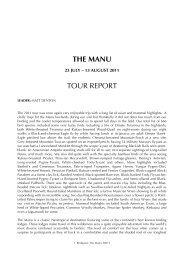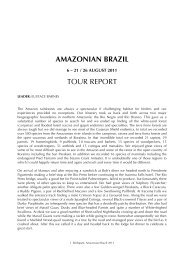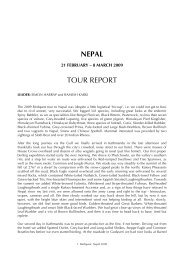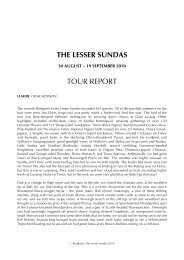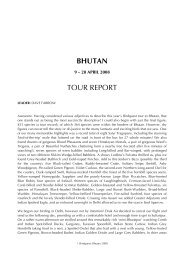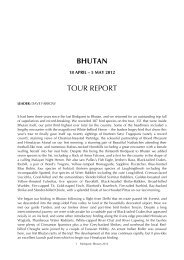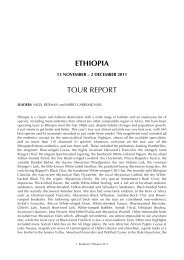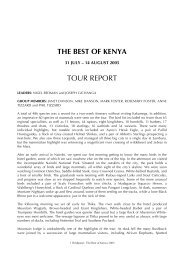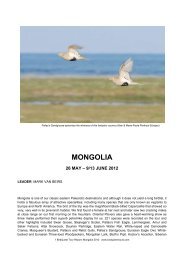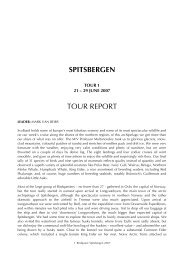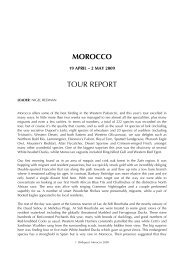THE CAPE VERDE ISLANDS TOUR REPORT - Birdquest
THE CAPE VERDE ISLANDS TOUR REPORT - Birdquest
THE CAPE VERDE ISLANDS TOUR REPORT - Birdquest
You also want an ePaper? Increase the reach of your titles
YUMPU automatically turns print PDFs into web optimized ePapers that Google loves.
After a rather sleepless night on Ilheu dos Passeros the boat arrived soon after 0700, but getting back<br />
on was probably slightly wetter than getting off the previous evening. However spirits were high and<br />
a little bit of sea water around the waist wasn’t going to dampen them much. Once off the island we<br />
went back to Sal Rei for breakfast and then to Rabil Lagoon for a quick look around. Once at the site,<br />
we realized the water level was well down on previous years which is worrying, and we heard that<br />
the huge construction projects nearby were just taking the water they needed from the lagoon as it<br />
was a ‘free’ source. Ecological problems aside, the lagoon was still attractive to waterbirds and there<br />
were a reasonable selection of waders, the best of which were a couple of Ruffs and a Lesser<br />
Yellowlegs. In the afternoon we took a flight over to Santiago but there was a delay of just over an<br />
hour which for TACV is actually quite good but meant that our arrival at our hotel was somewhat<br />
later than anticipated. They were waiting for us but the food took a while to prepare and it was rather<br />
late by the time we retired for the night.<br />
Our first port of call on Santiago was the heavily vegetated valley around Boa Entrada. This is usually<br />
an excellent site for the endemic Cape Verde Warbler but this morning things didn’t seem to work<br />
out. All we managed with the warbler were a few distant calls and a very brief sighting by one<br />
observer. Perhaps the increased activity in the valley may have effected the population but the<br />
vegetation seems the same so perhaps it was just a bad day. The local populations of Grey-headed<br />
Kingfisher and Common Waxbill do seem to have maintained their status in the area and we got<br />
some excellent views of both these species. From here we moved on to the botanic gardens at São<br />
Jorge dos Orgãos where we stopped for our lunch but within minutes of our arrival we had located a<br />
pair of very vocal and showy Cape Verde Warblers that were also very photogenic. Also whilst at the<br />
same location Tommy and Ilona saw a distant Cape Verde Buzzard which fortunately put in a repeat<br />
appearance and was seen by all of us, but it was still rather distant. After consuming the rest of a<br />
rather interrupted picnic we made our way to the Barragem de Poilão which is the best freshwater<br />
site on Santiago. Although the site was still good the water level had dropped dramatically since last<br />
year and the site may not be functional for birdwatchers within the next three years or so. Doom and<br />
gloom aside the site is still good and we recorded a good selection of species here including the<br />
highly prized Bourne’s Heron. This rare endemic is now known to have a pair breeding at a new<br />
location inside the Serra Malagueta Natural Park but the main breeding site is still the tree in Liberão<br />
which as the crow flies is just a short distance from the reservoir. We also saw Glossy Ibis and Little<br />
Ringed Plover at this site which were new species for the <strong>Birdquest</strong> Cape Verde list, a fine subadult<br />
American Purple Gallinule which was the first record for the islands, a Lesser Yellowlegs and the<br />
third Little Bittern for Cape Verde, but we had known about all of these birds in advance and didn’t<br />
discover anything new ourselves. Less unusual species here included Eurasian Spoonbill, Common<br />
Snipe, Common Greenshank and Green and Wood Sandpipers.<br />
On the penultimate day of our trip, we returned to the Barragem de Poilão, but the birds were much<br />
the same as yesterday, and we could not locate the previously reported Intermediate Egret even<br />
though we waited for a couple of hours or more just in case it decided to drop in. We then went<br />
round to Liberão for our picnic which we took by the Bourne’s Heron nesting tree, but as expected<br />
the birds that were seen earlier in the month had departed, and the tree was empty apart from the old<br />
nests. After a short while we continued along the minor road which although rather scenic produced<br />
no birds of note, but a few nice views. We then returned to São Jorge dos Orgãos where the Cape<br />
Verde Warblers entertained us again before we returned to Tarrafal. In the evening, prior to dinner,<br />
we went out to the abandoned sewage ponds to try for a Cape Verde Barn Owl but none appeared<br />
and we had to go back to the hotel with just three Black-crowned Sparrow-larks for our trouble.<br />
In the morning of our last day we tried the coastal lagoons at Pedra Badejo but after an hour and a<br />
half to get there it was disappointing to find that this was another site that had deteriorated. Water<br />
levels were very low and there were no birds present at all, at least we verified that this location need<br />
not be visited in the future. We took lunch back at Tarrafal where we were entertained by a few low<br />
level Cape Verde Swifts, the ever present Grey-headed Kingfishers and some of the more common<br />
4 <strong>Birdquest</strong>: The Cape Verde Islands 2008




